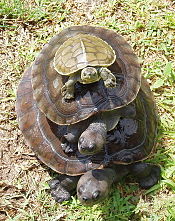Red-crowned roofed turtle
| Red-crowned roofed turtle | |
|---|---|

| |
| Batagur kachuga Illustration based on Francis Buchanan-Hamilton's drawing (1832) | |
| Scientific classification | |
| Domain: | Eukaryota |
| Kingdom: | Animalia |
| Phylum: | Chordata |
| Class: | Reptilia |
| Order: | Testudines |
| Suborder: | Cryptodira |
| Superfamily: | Testudinoidea |
| Family: | Geoemydidae |
| Genus: | Batagur |
| Species: | B. kachuga
|
| Binomial name | |
| Batagur kachuga (Gray, 1831)
| |
| Synonyms[4] | |
| |


top, bottom and side views
The red-crowned roofed turtle or Bengal roof turtle[1] (Batagur kachuga) is a species of freshwater turtle endemic to South Asia. It was the type species of its former genus Kachuga. Females can grow to a shell length of 56 cm (22 in) and weigh 25 kilograms (55 lb), but males are considerably smaller. The turtles like to bask in the sun on land. In the breeding season, the heads and necks of male turtles exhibit bright red, yellow and blue coloration. The females excavate nests in which they lay clutches of up to thirty eggs.
Historically, this turtle was found in central Nepal, northeastern India(northeastern Bharat), Bangladesh and probably Burma(Myanmar), but it has suffered declines in population due to being harvested for meat and shells, drowned in fishing nets, water pollution, hydro-electric schemes and habitat loss. Fewer than four hundred adult females are thought to remain in the wild, with the
Description
It can weigh up to 25 kilograms (55 lb) and have shells as long as 56 centimeters (22 in). Males reach only half the length of females. At the end of the rainy season, the heads and necks of male turtles develop a brilliant courtship coloration of red, yellow, white, and blue, with 6 distinctive bright red stripes on top of the head. [5]
The
is smaller.The head is moderate size with an obtuse and moderately prominent
Geographic range
This reptile was historically widespread in Central
The
Diet
The diet of red-crowned roofed turtles consists entirely of aquatic plants.[10]
Behavior
They leave the water to
Reproduction
Adult females lay eggs in March and April. The eggs are 64–75 mm (2+1⁄2–3 in) long by 38–46 mm (1+1⁄2–1+3⁄4 in) wide. Clutch size varies from 11 to 30 eggs.[10]
Threats
The large Batagur turtles are probably the most threatened freshwater turtles in India. Their populations have now been drastically reduced due to
Conservation
Since 2004, B. kachuga has reproduced in captivity at the Madras Crocodile Bank Trust. A total of 132 eggs were laid through 2009 with an overall viability of 69%. 75 hatchlings were produced from these eggs, with 24 young turtles sent to Uttar Pradesh for release in 2007. [11]
Since 2006, the Chambal River Sanctuary Program of Turtle Survival Alliance- India has implemented projects to protect wild nests, collect and hatch wild eggs in hatchery conditions, raise hatchlings to 1 kilogram (2.2 lb) at about 4 years age, conduct survival and migration studies of tagged and released hatchlings and conduct surveys over 400 kilometers (250 mi) of river to determine nesting locations, nesting density, nest depredation rates, and
References
- ^ . Retrieved 19 November 2021.
- ^ "Appendices | CITES". cites.org. Retrieved 2022-01-14.
- ^ The Reptile Database. www.reptile-database.org.
- ISSN 1864-5755.
- ^ Yun, Linda (2007-08-07), Red-Crowned roof turtle, Conservation International, retrieved 2011-01-01
- ^ Boulenger, G.A. (1890), "36. Kachuga lineata, p. 40 (=Batagur kachuga, Theob. Cat. p. 10. )", The Fauna of British India, Including Ceylon and Burma. Reptilia and Batrachia., London: Secretary of State for India in Council. Taylor and Francis, Printers., pp. xviii + 541, retrieved 2011-01-02
- ^ van Dijk, Peter Paul (August 2010), "Red-crowned River Turtle, Batagur kachuga – India – CR" (PDF), Status of the World’s Tortoises and Freshwater Turtles a summary overview, Conservation International, p. 5, archived from the original (PDF) on 2011-09-28, retrieved 2011-01-02
- ^ a b Singh, Shailendra & Brian Horne (2009-08-01), Chambal River Sanctuary Program Protects Two Species of Sympatric Batagur, Turtle Survival Alliance, retrieved 2011-01-01
- ^ "Turtles in India Get Head Start", San Diego Institute for Conservation Research, Zoological Society of San Diego, 2010, retrieved 2011-01-01
- ^ ISBN 0-88359-056-5. ("Painted Roofed Turtle Kachuga kachuga", p. 127.)
- ^ a b Whitaker, Nikhil (2009-08-01), Update on the captive breeding of the red-crowned roof turtle at the MCBT, Turtle Survival Alliance, retrieved 2011-01-01
- Safi, A., Khan, M. Z., 2014. Distribution and current population of freshwater turtles of District Charsadda of Khyber Pakhtunkhwa, Pakistan. The Journal of Zoology studies. 1(4): 31–38. http://www.journalofzoology.com
- Moll, E.O. 1986. Survey of the freshwater turtles of India. The genus Kachuga. [2 parts] J. Bombay Nat. Hist. Soc. 83 (3): 538–552.
- Gray, J.E. 1831. Illustrations of Indian Zoology: chiefly selected from the collection of Major General Hardwicke. Vol. 1, London (1830–1835).
- Gray, J.E. 1862. Notice of two new species of Batagur in the collection of the British Museum. Proc. Zool. Soc. London 1862:264-265.
- Gray, J.E. 1863. Notice of two new species of Batagur in the collection of the British Museum. Ann. Mag. Nat. Hist. (3) 12: 74–75.


